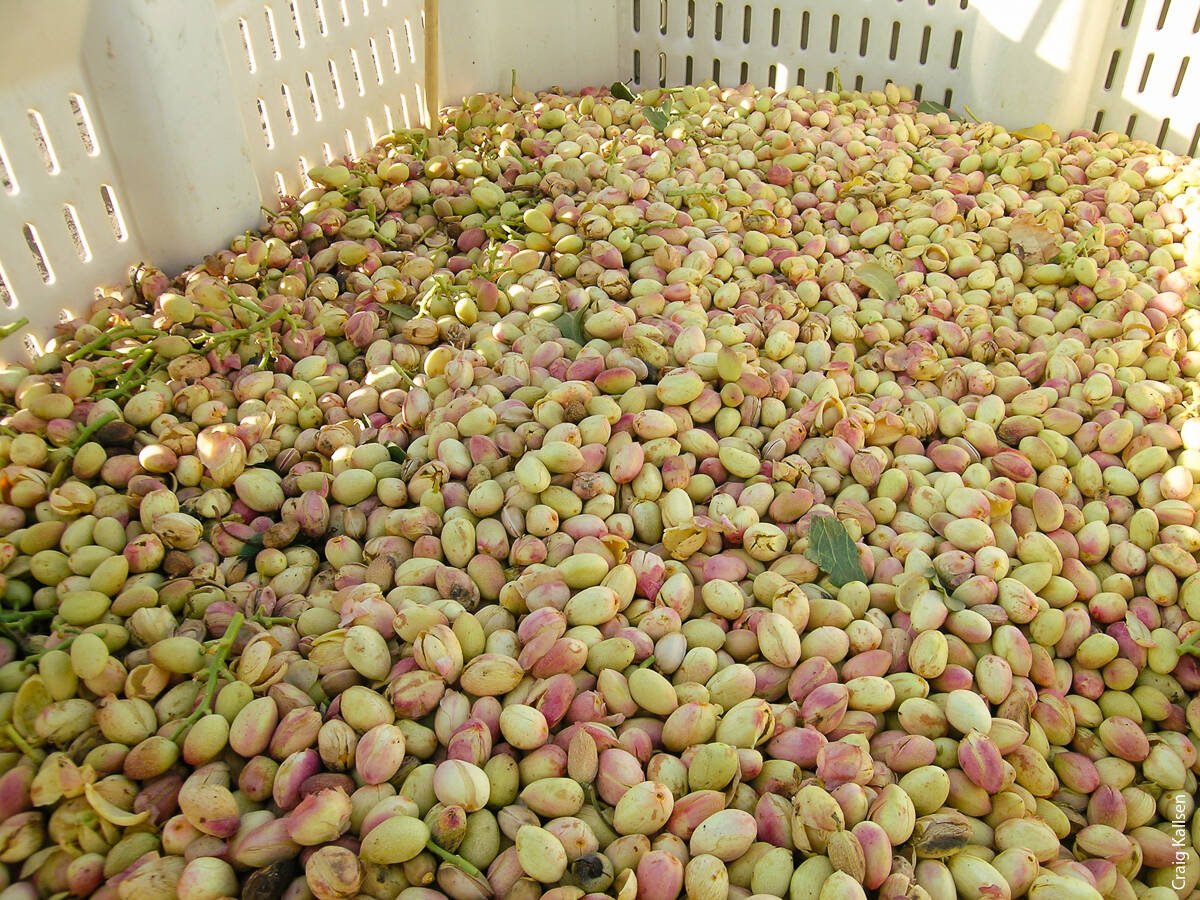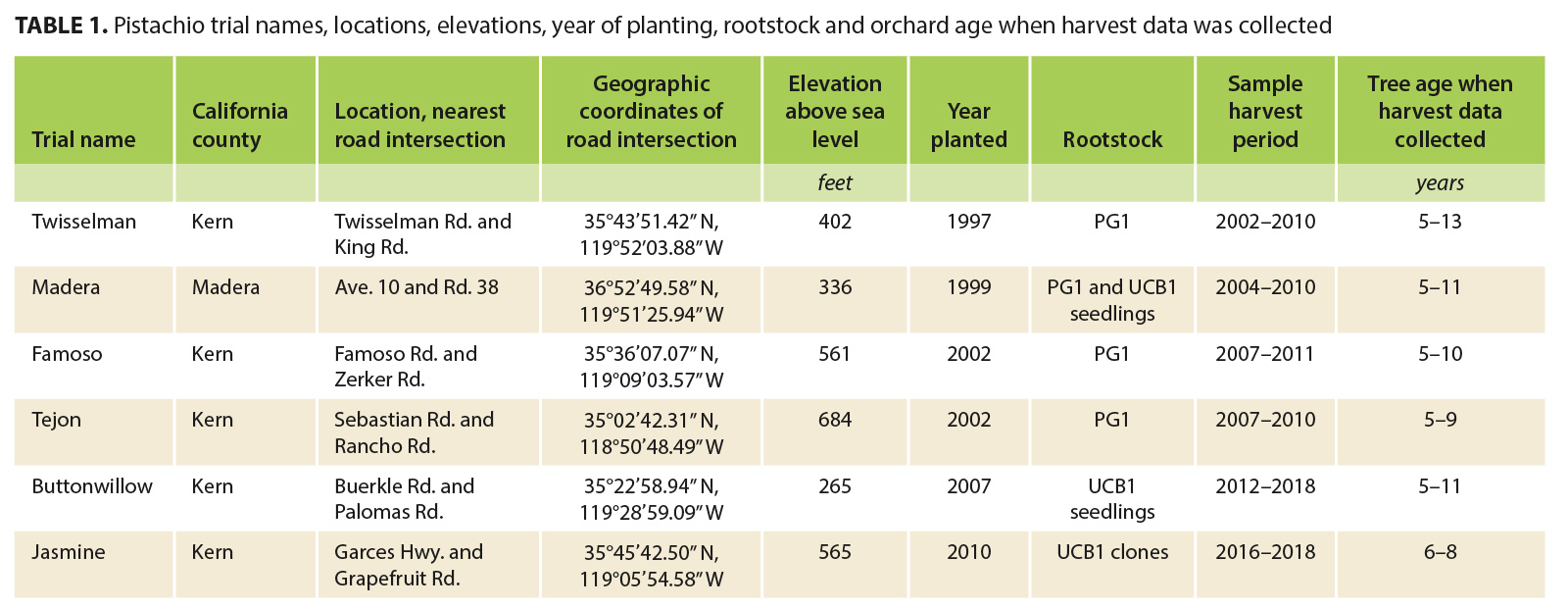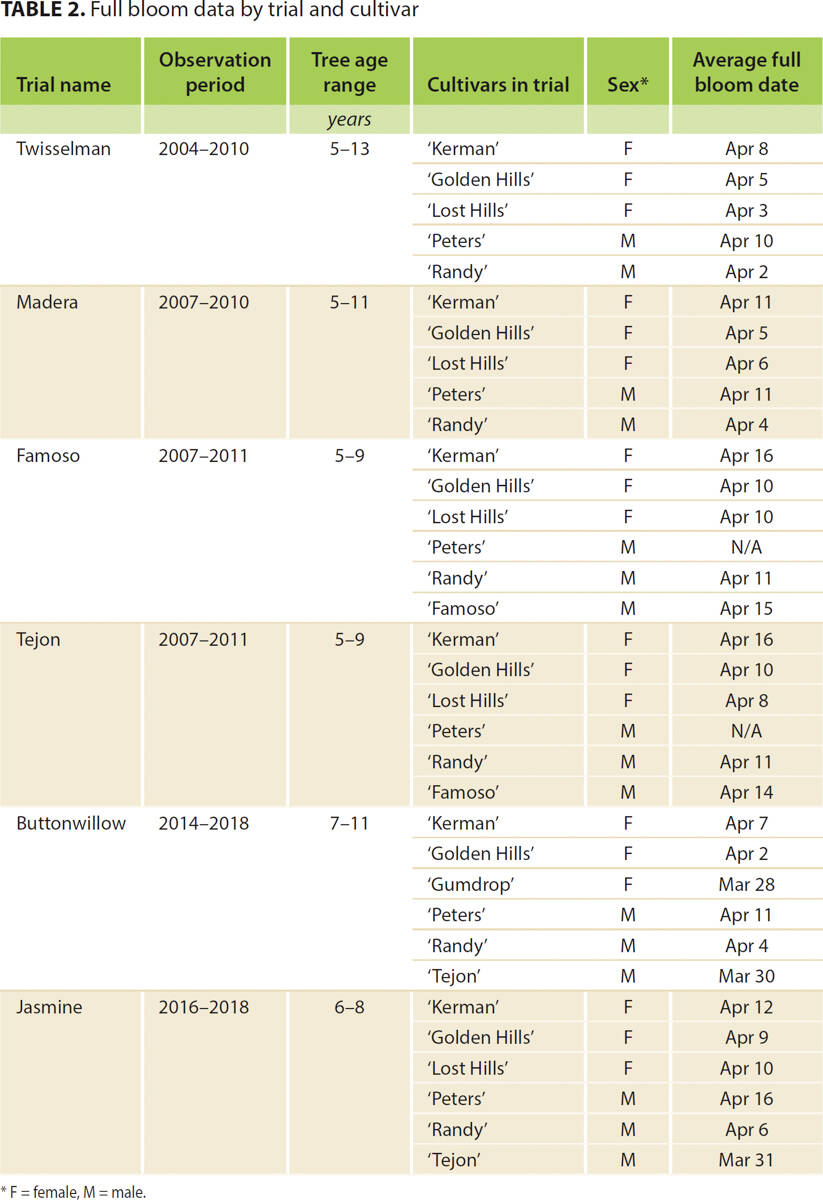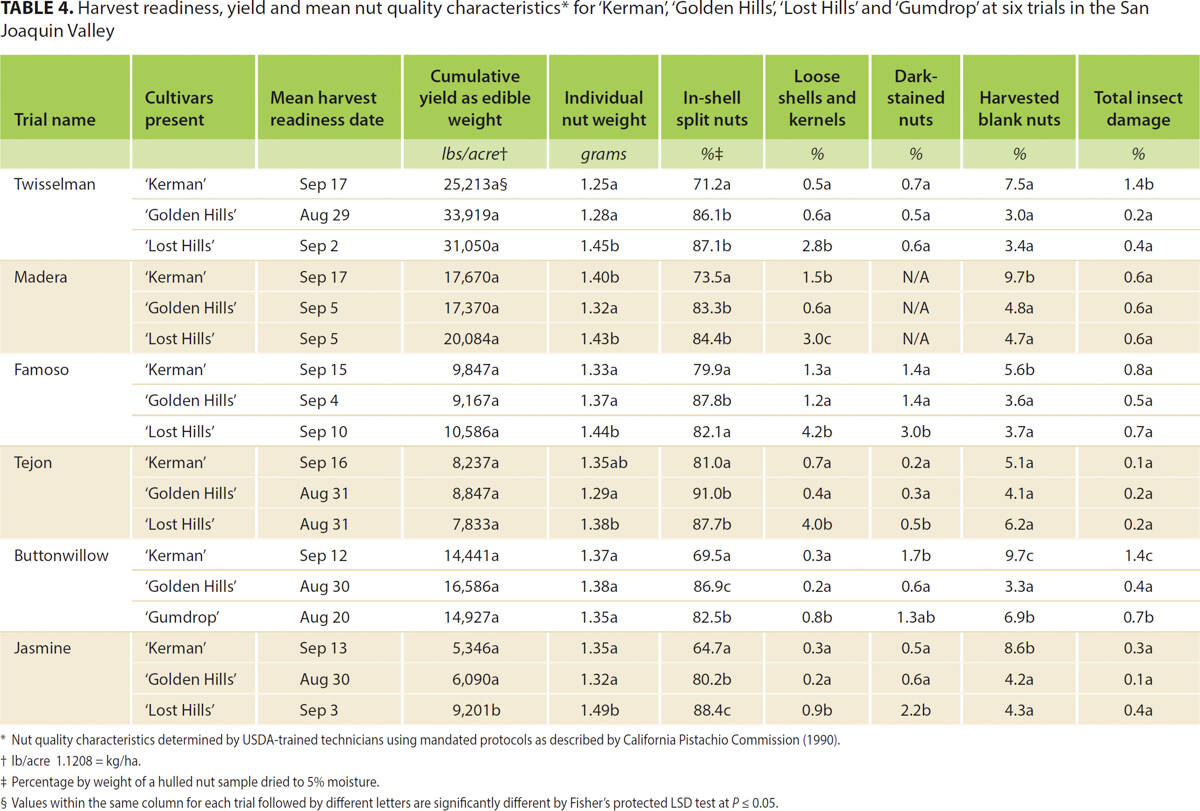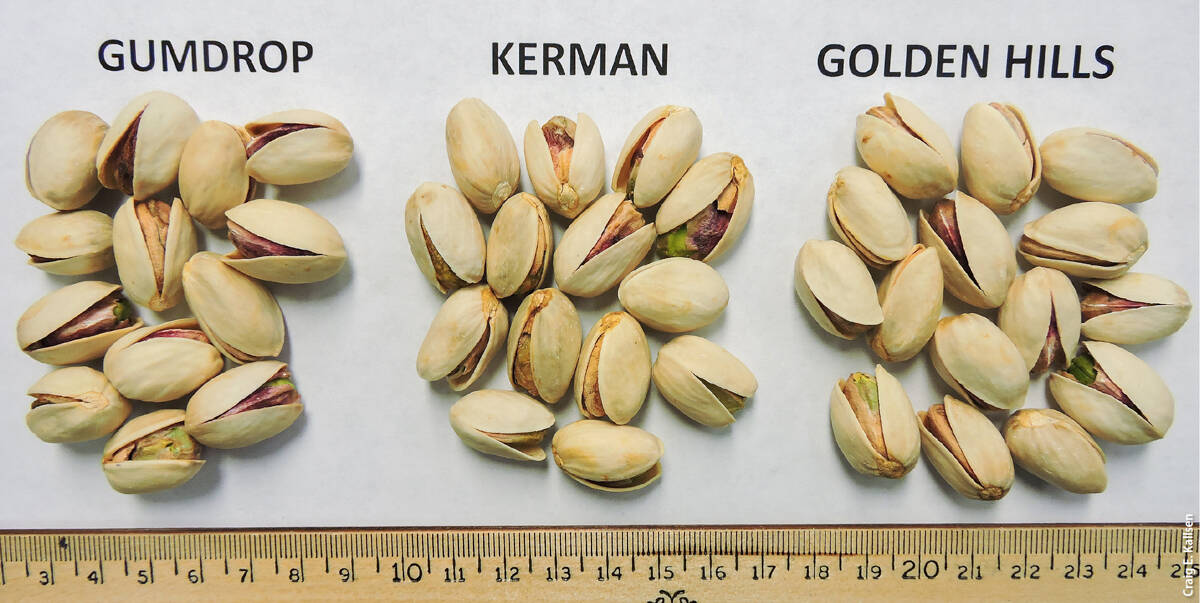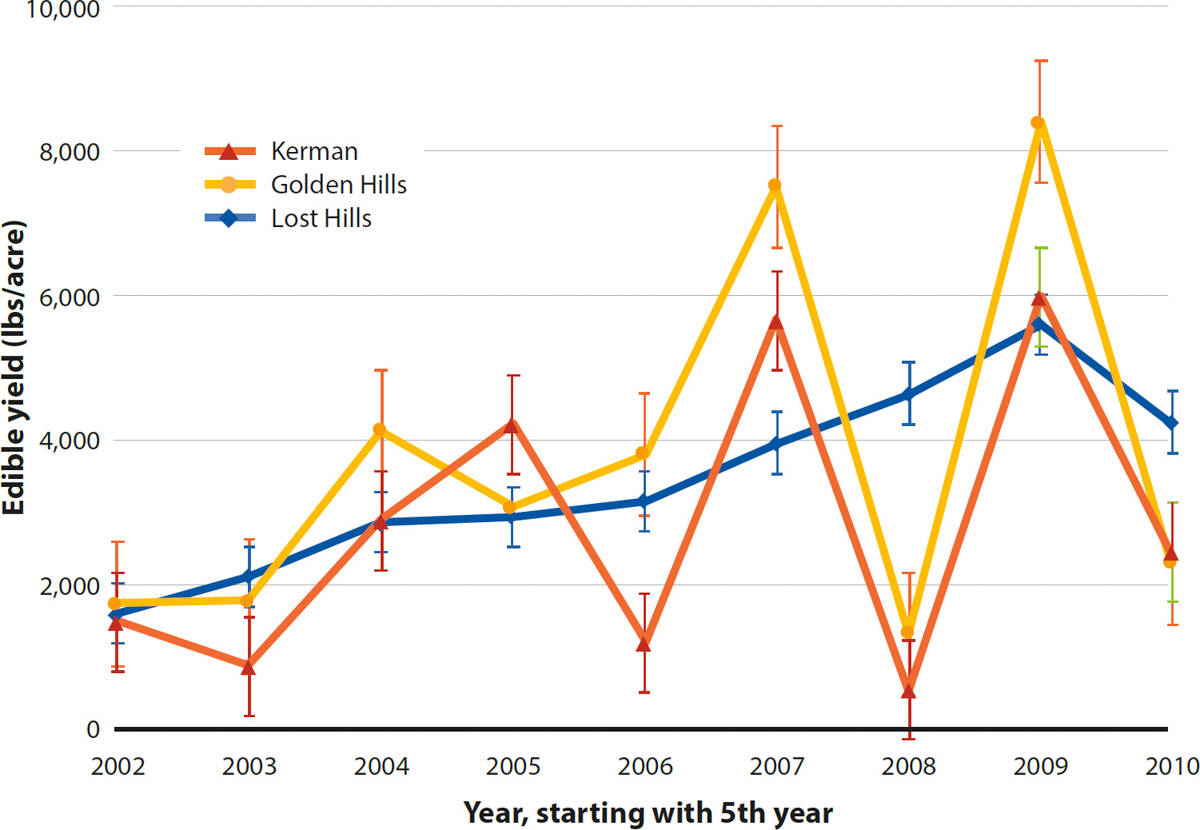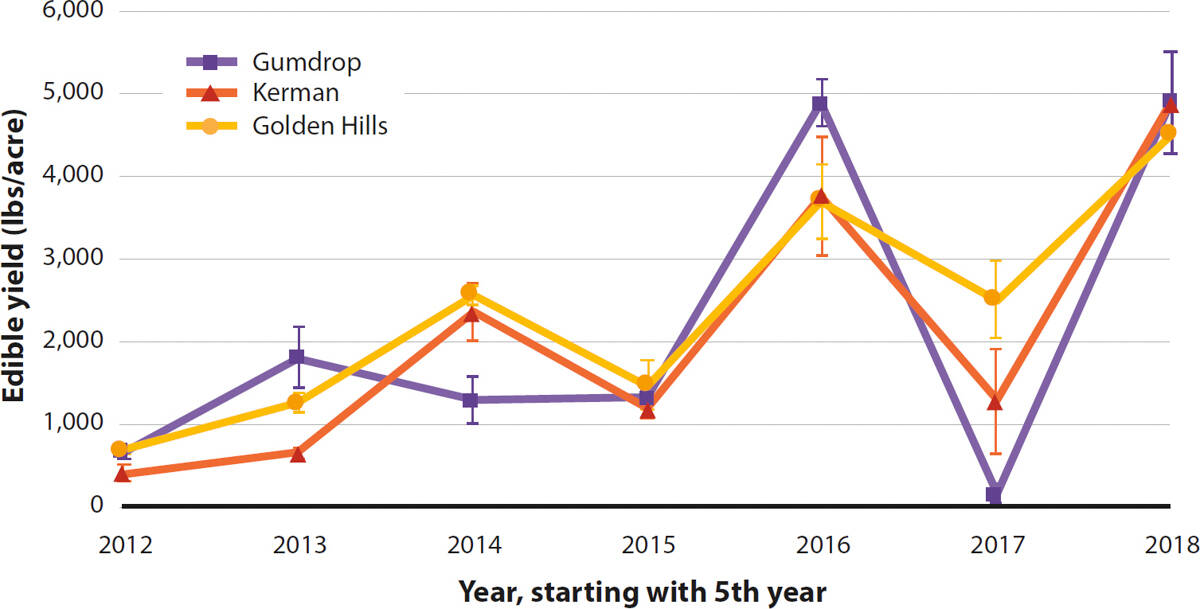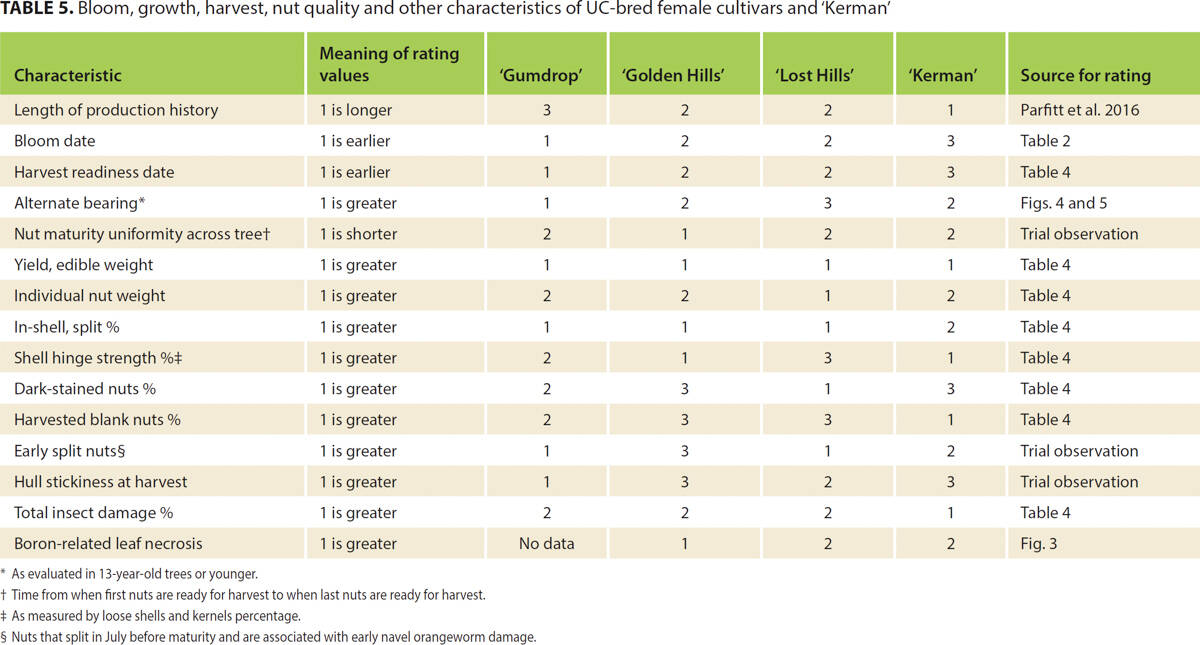All Issues
UC pistachio cultivars show improved nut quality and are ready for harvest earlier than ‘Kerman’
Publication Information
California Agriculture 74(2):86-93. https://doi.org/10.3733/ca.2020a0011
Published online June 09, 2020
PDF | Citation | Permissions
Abstract
California pistachio growers have traditionally grown only one female cultivar (‘Kerman’) and one male pollenizer (‘Peters’). Starting in 2005, the UC breeding program released several improved cultivars, which are being planted on increasing acreage — and tested now under commercial conditions at multiple sites over multiple years. We conducted six experimental trials in the San Joaquin Valley to evaluate the performance of the UC cultivars ‘Gumdrop’, ‘Golden Hills’ and ‘Lost Hills’ and their associated UC male pollenizers ‘Famoso’, ‘Randy’ and ‘Tejon’ against the performance of the traditional pair, ‘Kerman’ and ‘Peters’. The new cultivars demonstrated a range of earlier bloom and harvest dates than ‘Kerman’ and some improved nut quality characteristics, such as a higher percentage of split, in-shell nuts. Results indicate that by growing the new female cultivars and synchronous pollenizers, producers can avoid the peak harvest period for ‘Kerman’, when equipment and processing facilities are limited, and maintain or improve their yield and nut quality.
Full text
Until the release of the first pistachio cultivars from the UC breeding program in 2005, the industry was almost entirely dependent on one female cultivar (‘Kerman’) and a single male pollenizer (‘Peters’). While ‘Kerman’ remains a valuable commercial cultivar, it is not a perfect selection for all conditions. Some of the weaknesses of ‘Kerman’, described by Kallsen et al. (2009), include nut quality issues such as the failure of the nutshells to split, or to produce a kernel (blank nuts). Also, in years with an insufficient winter rest period such as occurred in 2014 and 2015, inadequate bloom synchrony has been evident between ‘Kerman’ and ‘Peters’.
The biggest problem with ‘Kerman’, however, is the large and expanding ‘Kerman’ acreage planted during the last 30 years. Pistachio production, predominantly ‘Kerman’, has grown particularly rapidly in the last 15 years; total planted pistachio acreage in California increased from 196,000 acres in 2008 to 330,000 in 2017 (CDFA 2018). Within the San Joaquin Valley, where most of the pistachio production occurs, the entire ‘Kerman’ crop ripens at about the same date, with a peak harvest duration of 3 to 4 weeks. Pistachio is an alternate-bearing crop, with a heavy-bearing year followed by a light-bearing year, and the cycle tends to become synchronized across the state, resulting in huge crops during the on-bearing years. Harvesting these huge crops is beginning to exceed the harvest capacity of the industry. Shortages of harvesting equipment, trucks, processing facility capacity and trained personnel are common.
‘Golden Hills’ nuts in the bin at harvest. Results from trials of UC-bred cultivars show that the new cultivars have earlier harvest dates and improved nut quality.
Producers have begun to alleviate the worst of the peak demand problem by planting the new UC cultivars with harvest maturity dates different from ‘Kerman’. Acceptance of UC-bred cultivars, especially ‘Golden Hills’, has been noteworthy. Since 2014, ‘Golden Hills’ has been the cultivar of choice for most of the new pistachio acreage (fig. 1). About 86,000 acres of ‘Golden Hills’ and 10,000 acres of ‘Lost Hills’ were in the ground as of 2018.
FIG. 1. Since 2014, ‘Golden Hills’ has accounted for most of the new planted acreage, according to National Agricultural Statistics Service (NASS) estimates of total new planting acreage from 2008 to 2017 and per-tree royalty payments for ‘Golden Hills’, assuming 140 trees planted per acre.
Commercial production history can be an important consideration for many producers when choosing a cultivar. ‘Kerman’ has been widely planted since it was made available to the industry in the 1950s, has been proven successful under a broad range of soil conditions, weather extremes, geographic conditions, tree maturity and producer production practices. ‘Golden Hills’ and ‘Lost Hills’ were released to the industry in 2005 and ‘Gumdrop’ in 2016. To help producers compare the commercial performance of the new cultivars to ‘Kerman’, we pulled together data from six long-term trials (some of them ongoing) in the San Joaquin Valley.
Twelve-year-old variety trial showing earlier leaf-out and bloom of the ‘Gumdrop’ cultivar (left) compared to ‘Golden Hills’(right) on April 10, 2019.
Six trials in San Joaquin Valley
We evaluated the growth and production characteristics of six pistachio cultivars bred, patented, technically described and released by UC. These cultivars are the females ‘Golden Hills’ (Parfitt et al. 2007), ‘Lost Hills’ (Parfitt et al. 2008) and ‘Gumdrop’ (Kallsen and Parfitt 2017) and the males ‘Randy’ (Parfitt et al. 2010), ‘Famoso’ (Kallsen and Parfitt 2018) and ‘Tejon’ (Kallsen and Parfitt 2019). Data were collected from six trials in the southern San Joaquin Valley (table 1), although not all cultivars were present in all trials (table 2).
TABLE 1. Pistachio trial names, locations, elevations, year of planting, rootstock and orchard age when harvest data was collected
Methods used for determining bloom, yield and nut quality characteristics were described in Parfitt et al. (2007) and Kallsen et al. (2009). The experimental trials were replicated, randomized and located within larger blocks of ‘Kerman’ under standard irrigated-production conditions (Brar et al. 2015). Row and tree spacing were variable among trials (18 to 20 feet between rows and 16 to 18 feet between trees). Depending on the trial, the cultivars were replicated in two to four blocks, with each replication consisting of one to 10 trees. The rootstocks to which the cultivars were grafted varied with the trial (table 1). The trees were harvested with poles or mechanical shaking. Nuts that remained firmly attached to the tree after harvest were not evaluated.
Bloom timing, suggested pollenizers
Pistachio is dioecious, and bloom synchrony between male and female cultivars is critical for adequate pollination and nut set. Specific pollenizers are associated with each female cultivar to provide pollen at female bloom. The mean full bloom dates across trials (table 2) for the female cultivars were April 12 for ‘Kerman’, April 7 for ‘Golden Hills’ and ‘Lost Hills’, and March 28 for ‘Gumdrop’. Mean full bloom date for the male cultivars were April 12 for ‘Peters’, April 6 for ‘Randy’, and March 31 for ‘Tejon’. On the basis of these mean full bloom dates across all trials and the mean full bloom dates at each trial location (table 2), we identified the most synchronous pollenizer for each female as its standard male (table 3).
TABLE 3. Suggested standard and supplemental male pollenizers for each female cultivar based on predicted average adequacy of winter rest period over life of orchard
However, pistachio bloom timing, and thus bloom synchrony in the spring, is affected by the adequacy of the rest period (also called chilling) in the previous winter, and the winter rest period requirement for pistachio is high compared to that of many fruit and nut crops (Ferguson and Kallsen 2016). Symptoms of an inadequate winter rest period include uneven and late foliation and bloom (Crane and Takeda 1979; Erez and Fishman 1988). On male and female trees, many buds fail to push, inflorescences desiccate before they flower or inflorescences remain small and nonproductive on the more sun-exposed leaf canopy.
Physiologists continue to grapple with how to quantify or measure the winter rest requirement of fruit and nut crops, in general (Luedeling et al. 2013; Melke 2015) and in pistachio in particular (Kallsen 2017; Zhang and Taylor 2011), because the underlying physiology is not well understood. Although difficult to quantify, it has been apparent that the adequacy of the winter rest periods for pistachio has ranged from low to high in the San Joaquin Valley, depending on orchard location and year. For the purposes of this article, the adequacy of the winter rest period in 2014 and 2015 was considered low, and the adequacy of the typical winter rest period in the San Joaquin Valley was considered moderate. For comparison, a high adequacy rating is more typical of the pistachio-growing area around Wilcox, Arizona.
Our suggestions for pollenizers in table 3 take account of canopy and flower development observations made in years when the adequacy of the winter rest period was low. Bloom synchronization between the female tree and the standard male pollenizer decreased during years with an inadequate winter rest period. In these years, the standard male pollenizer tended to bloom later than the associated female cultivar. For example, at the Buttonwillow trial in 2014 and 2015, ‘Randy’, the standard pollenizer for ‘Golden Hills’ and ‘Lost Hills’, was at full bloom at the same time as ‘Kerman’ (fig. 2). Similarly, ‘Tejon’, the standard pollenizer for ‘Gumdrop’, had closer synchrony with ‘Golden Hills’ (fig. 2), which left the early-blooming ‘Gumdrop’ without an overlapping pollenizer.
FIG. 2. Timing of full bloom for male (m) and female (f) cultivars in the Buttonwillow trial during the spring of 2014 and 2015, which were years with an inadequate winter rest period. The standard male cultivar has the same color as the associated female.
As the future winter rest period in the San Joaquin Valley is predicted to become even less adequate (Baldocci and Waller 2014; Leudeling et al. 2009), in some situations we suggest planting a supplemental pollenizer, in addition to the standard male (table 3). However, ensuring bloom synchronization does not guarantee adequate pollination and yield potential in years with an inadequate winter rest period. The quantity of pollen per flower in ‘Randy’ and ‘Peters’ was reduced measurably in 2015 at the Famoso trial (Kallsen and Parfitt 2017) compared to in 2016, when a more adequate winter rest period occurred; similar detrimental effects from inadequate winter rest are also likely on flower and seed development in female trees. It is noteworthy that ‘Gumdrop’ demonstrated less intense symptoms of inadequate winter rest than the other cultivars. There is some correlative evidence within other crops that earlier-blooming cultivars have a lower winter rest requirement than later-blooming cultivars (Gao et al. 2012).
Precocity matches
“Precocity” is defined as the number of years between planting and the first year of flowering. Females that are more precocious can produce a crop sooner if suitable pollen is available. ‘Peters’ tends to remain vegetative in the 4th and 5th years after planting as ‘Kerman’ begins to flower, reducing nut yield. In addition to its bloom synchrony with ‘Kerman’, one of the criteria used in identifying and selecting the new pollenizer ‘Famoso’, from the initial seedling evaluation trials, was its similar precocity with ‘Kerman’, which should allow for bigger nut yields in the early years of the orchard.
Tree growth characteristics
The female cultivars in this study vary in tree growth characteristics. ‘Golden Hills’ grew upright, with willowy branches. ‘Kerman’ and ‘Lost Hills’ had less upright growth and their trunk diameter increased faster than ‘Golden Hills’. ‘Gumdrop’ had a stouter growth habit than the other cultivars; its trunk increased in girth quickly and its branches were much thicker and tapered less toward the tip. ‘Kerman’ was the most vigorous of the cultivars and required more pruning to maintain upright growth as a mature tree.
UC cultivars increased in trunk circumference faster than the rootstock. The result was overgrowth at the graft union. Overgrowth was most noticeable when UC cultivars were grown on PG1 rootstock (i.e., a rootstock with 100% Pistacia integerrima heritage) (Kallsen and Parfitt 2011). Overgrowth can make firm attachment of the harvest shaker to the tree trunk difficult and may result in bark damage. For this reason, grafting should occur at 28 to 32 inches (0.71 to 0.81 meters) above ground level (Brar et al. 2015).
Boron-related leaf necrosis
The concentration of boron in the leaves of ‘Golden Hills’ was greater than for ‘Lost Hills’ or ‘Kerman’ on PG1 and UCB1 rootstocks (Kallsen and Parfitt 2008). This resulted in leaf necrosis along the outer edge of the leaves when soil and water boron were elevated (fig. 3) and early defoliation where soil and water boron concentrations were high.
FIG. 3. Dry weight concentration of boron in leaf tissue of ‘Kerman’, ‘Golden Hills’ and ‘Lost Hills’ on PG1 rootstock at the Twisselman trial. ‘Golden Hills’ had greater leaf edge burn due to boron toxicity than did ‘Lost Hills’ or ‘Kerman’. Error bars represent ± 2 times the SE of the mean.
Harvest timing, extended season
The most valuable characteristic of the UC cultivars seen in these trials was their earlier harvest compared to ‘Kerman’ (table 4). The mean harvest readiness dates across the six trials were Aug. 20 for ‘Gumdrop’, Sept. 1 for ‘Golden Hills’, Sept. 4 for ‘Lost Hills’ and Sept. 15 for ‘Kerman’. ‘Gumdrop’ was present only at the Buttonwillow trial (table 4). Nuts of ‘Gumdrop’ were ready for harvest approximately 23 days earlier on average than those of ‘Kerman’. Earlier harvest increases the efficiency of the industrywide pistachio harvest by extending the harvest season and thus reducing peak demand for labor, harvesting equipment and nut processing facilities.
TABLE 4. Harvest readiness, yield and mean nut quality characteristics∗ for ‘Kerman’, ‘Golden Hills’, ‘Lost Hills’ and ‘Gumdrop’ at six trials in the San Joaquin Valley
Nut yield and quality
A pistachio nut has an outer hull covering a shell, which encloses a kernel (i.e., meat). Yield in this study was expressed as edible weight, which also is called grower-paid weight. Edible weight is the weight of nuts after hull removal, adjusted to 5% moisture, minus culls and the weight of shells from nonsplit nuts (California Pistachio Commission 1990). Shell plus kernel, called an in-shell, split nut, is the major commercial product marketed in California although shell-less kernels are increasing in popularity. For the producer to be paid for the weight of the shell, the shell must be split and contain an edible kernel. If the shell is split but dark stained, the producer is paid only for the weight of the kernel.
Generally, cumulative edible weight at each trial site was similar among the cultivars (table 4). ‘Golden Hills’ and ‘Lost Hills’ produced a higher in-shell, split nut percentage by weight than did ‘Kerman’ (table 4), which had a higher percentage of nonsplit (i.e., closed-shell) nuts (data not shown). Dark shell staining is undesirable from a marketing standpoint (California Pistachio Commission 1990). No clear pattern was apparent among cultivars in the various trials for the degree of dark shell staining (table 4).
If the shell falls apart during hulling, the kernel is usually lost and discarded with the hulls. The percentage of loose shells and kernels is a measure of a cultivar's shell hinge strength. The percentage of loose shells and kernels was higher in ‘Lost Hills’ than the other cultivars (table 4).
‘Kerman’ had a higher percentage of blank nuts than other cultivars (table 4); blank nuts have no kernel and are of no value to the producer. Individual nut weight was greatest for ‘Lost Hills’ (table 4), as was nut size (data not shown).
Alternate-bearing patterns
Pistachio trees tend to produce high and low yields in alternate years, beginning when they are 8 or 9 years old. Alternate bearing is considered an undesirable trait, especially so since the production across the industry becomes synchronized into high- and low-bearing years. This synchronization complicates efficient harvesting, processing and marketing.
‘Lost Hills’ demonstrated less alternate bearing than other cultivars at the Twisselman trial (fig. 4) (Kallsen et al. 2007). ‘Gumdrop’ showed the greatest alternate-bearing pattern at the Buttonwillow trial (fig. 5). ‘Kerman’ and ‘Golden Hills’ were distinctly alternate bearing at the Buttonwillow trial as well (fig. 5), but not as severely as at the Twisselman trial (fig. 4).
FIG. 4. Variation in annual edible yield at the Twisselman trial. ‘Lost Hills’ demonstrated less alternate bearing. Error bars represent ± 2 times the SE of the mean.
FIG. 5. Variation in annual edible yield at the Buttonwillow trial. ‘Gumdrop’ demonstrated more extreme annual bearing than the other cultivars beginning in 2016. Error bars represent ± 2 times the SE of the mean.
Insect pests and early harvest
Evaluations of nut quality at the processing plant include damage by insects. The most important insect pest in the San Joaquin Valley is navel orangeworm because of the nut damage, which can end up in consumer packaging and is associated with aflatoxin contamination (Doster and Michailides 1999; Haviland et al. 2016).
Navel orangeworm populations increase geometrically as the harvest season continues into the fall. A timely early harvest reduces navel orangeworm nut infestation in ‘Kerman’ (Haviland et al. 2016). The UC cultivars in our trial were ready for harvest earlier than ‘Kerman’ (table 4) and had less insect damage than ‘Kerman’ on average in two of our trials. However, in general, insect damage was low (table 4).
Choosing a cultivar, future cultivars
Choosing a cultivar should be based on characteristics important to the producer. The UC cultivars demonstrated characteristics distinct from those of ‘Kerman’ and, thus, opportunities for choice when establishing a new orchard (table 5). The new cultivars demonstrated a range of earlier bloom and harvest dates than ‘Kerman’ and some improved nut quality characteristics, such as a higher percentage of split, in-shell nuts and fewer closed shell and blank nuts. Results indicate that by growing the new female cultivars and synchronous pollenizers, producers can avoid the peak harvest period for ‘Kerman’, when equipment and processing facilities are limited, and maintain or improve their yield and nut quality. Future cultivars should show improvements that will benefit the producer, processor, consumer, orchard worker and the environment. Through plant breeding, cultivars could, for example, have a reduced winter rest requirement, increased insect or plant disease resistance or tolerance, reduced need for pesticides, better harvestability and processability, greater salt tolerance and a lower water requirement. UC plant breeders are focusing their efforts on many of these objectives. Plant breeding and selection for a desired trait is not quick, even with the application of modern genomics. However, breeding and selection has a successful record and warrants continued investment.



